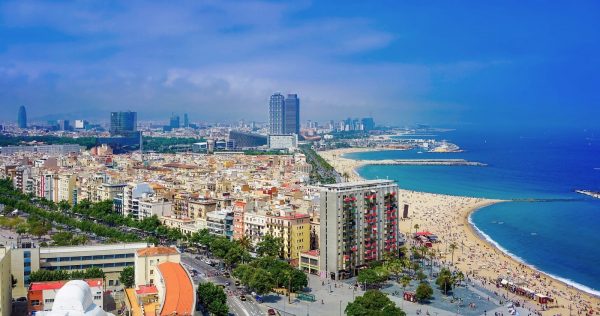Precipitation in 2017 was scarce, plunging Spain into its worst drought since 2008.

Barcelona, Spain. Photo courtesy of Pixabay.
Ten years ago, Barcelona nearly ran out of water.
In 2008, reservoirs dipped so low that the Mediterranean city was forced to import drinking water from France. The shortage came amid Spain’s driest year on record. The Catalonia region, home to Barcelona, was worst hit.
The story of water scarcity in northeastern Spain, however, doesn’t begin–or end–with the 2008 drought. Like Beijing or São Paulo or Karachi, Barcelona confronts a drying climate in a water-insecure region, while city leaders, though buttressed by one of Europe’s largest desalination plants, attempt to modernize a system to supply water effectively.
In the past decade, Barcelona has avoided a rerun of the 2008 water shortfall. Summers in Spain, though, are becoming hotter and drier, while winters are growing less harsh. Precipitation in 2017 was notably light, plunging Spain into its worst drought since it turned to its neighbors for water shipments.
The shift in climate threatens to leave Spain chronically parched. To avoid another emergency, Barcelona will need to adapt. Much of Barcelona’s water system is old and dysfunctional. An analysis in 2008 noted that one part of the system lost a startling 800,000 liters of water each day. According to water experts, improvements to the city’s infrastructure are crucial for averting future crisis.
Involving citizens and encouraging conservation is another important tactic for preserving water supplies. Earlier this year, the city established a drought protocol to help fight water shortages more effectively. It includes four levels of drought–pre-alert, alert, exceptionality, and emergency–and details the citywide “water-saving actions” that are recommended in each scenario. The goal is to maintain basic levels of water service even in severe droughts.
Eloi Badia, the Councillor for Presidency, Water, and Energy, says that Barcelona does not expect to reach the exceptionality or emergency stages of the protocol.
“The only thing we can envisage is the possibility of entering the alert stage,” said Badia, adding that domestic use will remain unaffected in that scenario. Overall, Badia says: “Citizens can have peace of mind.”
For now, Badia’s statement is believable. In contrast to many other parts of Europe, Spain has enjoyed favorable rainfall in recent months. This year’s crop production is expected to greatly surpass the low yields of 2017. The country’s long-term prospects, however, are less sure.
Where Will Water Come From?
In Spain, water distribution has been a tumultuous issue for decades. In 2001, the government proposed to pipe water from the Ebro River, in the north of Spain, to the country’s dry southeastern region. The plan involved constructing 110 dams along the Ebro, which begins in the Cantabrian mountains and flows 600 miles to the Mediterranean Sea.
The pipeline was met with fierce opposition from farmers and other northern residents, who feared it would cause environmental damages and upset livelihoods. The opposition culminated in a massive demonstration in Madrid in March 2001 that involved 120,000 protesters. In the end, pipeline construction began, but then languished, and was eventually halted following the election of new leaders.
Spain’s water woes, however, continued. In 2005, half of the country descended into the worst drought since 1945, when record-keeping began. Ninety-five percent of towns and cities in Catalonia, including Barcelona, put water restrictions in place.
When the 2008 drought arrived, Spain’s reservoir levels still had not fully recovered from the 2005 dry spell. By April 2008, reservoirs in northeast Catalonia had shrunk to 20.1 percent capacity, a mere 0.1 percentage points above emergency levels.
Water Emergency in 2008
As the drought deepened, so did concern over Barcelona’s water supply. The government announced that the city, Spain’s second-largest, was set to run out of drinking water by October. Hosepipe bans were enacted, public fountains were drained, and the city’s 1.6 million residents were urged to conserve water.
In an effort to keep taps from running dry, the government also proposed two major water-supply schemes. First, Catalonia arranged shipments of water from Tarragona, the port city south of Barcelona where the Ebro meets the Mediterranean. Second, the government announced plans to build an emergency pipeline to transfer water from the mouth of the Ebro to Barcelona.
Both plans were met with hostility. Other drought-stricken regions in Spain accused the central government of favoring Catalonia, its ally in the Spanish Parliament. Rice farmers along the Ebro insisted that they were unable to stop irrigating mid-season, a necessary prerequisite to laying the pipeline. Meanwhile, reservoirs levels in Catalonia slipped to 18 percent. At 15 percent, water in the reservoirs would no longer be fit for drinking.
Despite the controversy, the first shipload of water from Tarragona arrived in Barcelona on May 14, 2008, carrying 23 million litres of drinking water, enough to supply 180,000 people for one day. By then, Catalonia had secured shipments from France as well.
Just as the imported water began to arrive, Barcelona’s water situation started showing signs of improvement. Bouts of heavy rainfall boosted Catalonia’s reservoir levels to 30 percent–still below average, but safely above crisis levels. In early June, after another rise in reservoir levels, the central government scrapped the emergency pipeline plan.
Ultimately, the precipitation was enough to stabilize Barcelona’s water supply. In July 2009, a long-awaited desalination plant opened near the city. The plant, one of the largest of its kind in Europe, now provides 200 million litres of water per day, nearly a quarter of the city’s drinking water supply.
Barcelona Water Timeline, 2001-2018
Resources And Further Reading
120,000 damn the plan to transfer Spanish water (The Guardian)
Barcelona forced to import emergency water (The Guardian)
Barcelona gets new water supply (BBC)
EU wheat harvest to fall due heat in north, French crop damage: Reuters poll (Reuters)
Grapes shrivel as Spanish farmers lament a relentless drought (The Guardian)
Rain in Spain ends €169m pipeline plan (The Irish Examiner)
Ships bring water to parched Barcelona (BBC)
Spain plans pipeline to avert Catalan water crisis (Reuters)
Spain suffers worst drought (CNN)
Spain’s drought: a glimpse of our future? (The Independent)
Spanish forced to ration water (The Guardian)
Using water more efficiently to combat drought (Info Barcelona)
Kayla Ritter is a recent graduate of Michigan State University, where she studied International Relations and Teaching English to Speakers of Other Languages. She is currently based in Manton, Michigan. Kayla enjoys running, writing, and traveling. Contact Kayla Ritter




